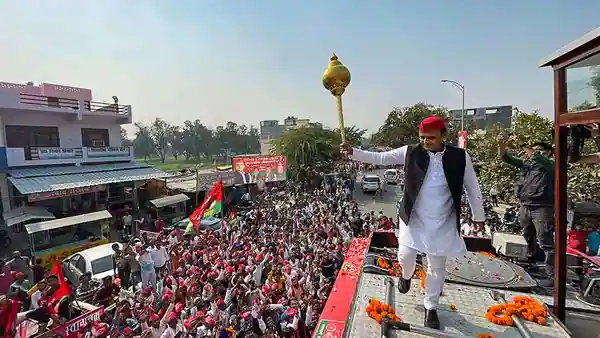I have covered many election rallies but never come as close to death as at a rally of Akhilesh Yadav, head of the Samajwadi Party, in Ballia, eastern Uttar Pradesh, on March 1. Some of us journalists had been allowed into the security zone 30 yards wide in front of the raised speakers’ dais, protected by barriers to keep the enthusiastic crowd at a safe distance. But when Akhilesh arrived, the excited crowd knocked down the barriers and rushed towards the dais, eyes agog with delirious excitement, brandishing raised smartphones to snap him.
Some journalists were almost trampled to death in the stampede. I held two fellow-journalists tight so that the three of us together could withstand the stampede better than each of us alone. We just about managed to keep standing before the rush abated. Elsewhere one journalist was knocked to the ground and survived only because other journalists quickly surrounded and helped her up.
If the frenzy of the crowd was any indication of Uttar Pradesh as a whole, the Samajwadi Party has a good chance of winning. Akhilesh had the audience roaring its support. Rarely have I seen such a delirious election crowd.
At the rally of Prime Minister Narendra Modi at Sonbhadra the next day, BJP workers raised practiced slogans with gusto, but the rest of the crowd didn’t seem as enthusiastic. I have seen past rallies when Modi achieved magnificent rapport with the audience, throwing it questions and getting roars of approving answers. The crowd was friendly enough, but that electricity appeared to be missing this time.
He spoke of extricating Indians stranded by the war in Ukraine and keeping India’s prestige high in the world. He hit out at those who sneered at Indian troops, atmanirbhar or Make in India policies. He claimed that the government had done a fantastic job in vaccinating and providing free rations to 80 crore Indians, more than the entire population of most countries. He boasted of being the only party to provide houses for poor, piped drinking water and electricity to all homes, Minimum Support Prices and PM Kisan grants to farmers. Alas, the audience reaction suggested that this was stale fare it had already heard many times in the campaign. It did not stir passions and stiffen sinews.
A notable feature of his speech was that he said nothing of the Ram Mandir or other communal matters. My conversations with voters in eastern UP also revealed a welcome lack of communal tension, with the vast majority of Hindus and Muslims saying religion was not an issue. Claims of armchair analysts that the BJP campaign is fuelled by communal hate are vastly exaggerated.
Modi claimed that the BJP would provide “vikas” (development). The audience politely clapped. But the pace of GDP growth in UP has been among the slowest in India in Yogi Adityanath’s term as chief minister. Covid has hit the state especially hard since it depends heavily on remittances sent home by migrant workers in other states, and lockdowns deprived these migrants of work and income. High inflation, now exacerbated by the Ukraine war and rise in oil prices, has taken a heavy toll.
The next day, we witnessed a rally of UP chief minister Yogi Adityanath that was a picture in contrast with Akhilesh’s in terms of audience enthusiasm. The crowd was small, occupying only part of a college games field. Many people started walking out even as he was narrating his many achievements. Some analysts regard him as a natural successor to Modi, but he did not look the part at the rally.
There is a statistician within me that says these are mere anecdotes unbacked by hard data. Even if the BJP fares very badly in the areas of eastern UP that we visited, it could conceivably do quite well in other areas. Conversations with voters reflected substantial support for the BJP too. But my gut feel, affected no doubt by my near-trampling at the Akhilesh rally, is that opinion polls predicting a BJP victory may prove to be off the mark.
There is also a cynic within me that says elections do not clinch outcomes. Post-election manipulation can matter more. The BJP lost the state election in Karnataka in 2017 and in Madhya Pradesh in 2018, but later managed to buy enough legislators of the ruling party to come to office. There is an old saying that money cannot buy elections: no matter how much cash you spend, you cannot purchase voters seeking change. But money can buy legislators. If the Samajwadi Party and allies win by only a slim margin, they will be vulnerable.
This article was originally published in The Times of India on March 5, 2022.


